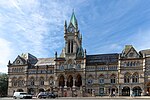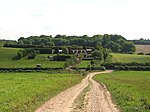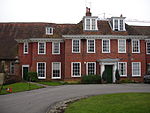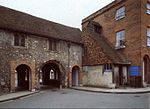Rout of Winchester

In the Rout of Winchester (14 September 1141) the army of imprisoned King Stephen of England, led by his wife, Queen Matilda of Boulogne, Stephen's brother Bishop Henry of Blois, and William of Ypres, faced the army of Stephen's cousin Empress Matilda, whose forces were commanded by her half-brother Earl Robert of Gloucester. After Empress Matilda's army besieged a castle on the edge of Winchester, Queen Matilda's army arrived and blockaded the Angevin army within the city. Cut off from supplies, the Angevin army gave up the siege, then was crushed as it began to retreat. Robert of Gloucester was captured and was subsequently exchanged for Stephen, who was returned to the throne of England. However, the civil war known as The Anarchy dragged on with neither side gaining an advantage.
Excerpt from the Wikipedia article Rout of Winchester (License: CC BY-SA 3.0, Authors, Images).Rout of Winchester
Cathedral Close, Winchester The Close
Geographical coordinates (GPS) Address Website Nearby Places Show on map
Geographical coordinates (GPS)
| Latitude | Longitude |
|---|---|
| N 51.060494 ° | E -1.312523 ° |
Address
Winchester Cathedral (Cathedral Church of the Holy Trinity, and of St Peter and St Paul and of St Swithun)
Cathedral Close
SO23 9JP Winchester, The Close
England, United Kingdom
Open on Google Maps











